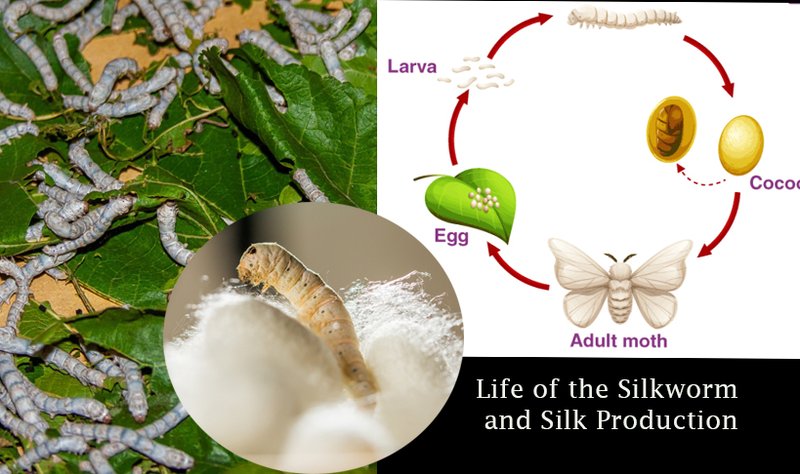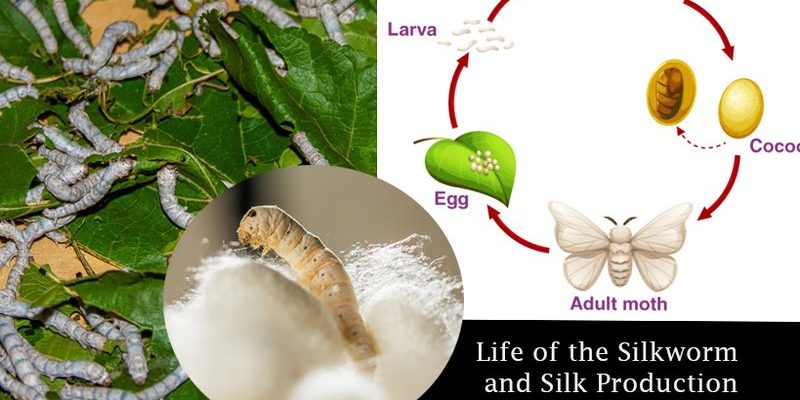
Silkworms are not just insects; they are a part of a fascinating story that begins in ancient China and stretches across continents and time. Their silk has a unique ability to shimmer like a calm lake under the moonlight while feeling as soft as a whisper against your skin. But how did these tiny creatures become pivotal in the history of textiles? Let me explain.
The Lifecycle of Silkworms
To appreciate the role of silkworms in textile history, we first need to understand their lifecycle. Silkworms start as tiny eggs, which hatch into larvae, known as caterpillars. These cute little guys are basically eating machines, consuming mulberry leaves until they’re ready to spin their cocoons.
Once they’ve reached their full size, they begin to create a cocoon from silk threads. This process is quite impressive; a single silkworm can produce about 1,000 to 3,000 feet of silk! That’s enough to make several garments. After spinning, they undergo metamorphosis, becoming moths, which eventually lay eggs to continue the cycle.
This lifecycle has been harnessed by humans for centuries. The entire process from egg to moth can take about six to eight weeks, making it an efficient way to produce silk. Isn’t it intriguing how nature has provided such a remarkable resource?
The Birth of Silk Production
Silk production, or sericulture, has its roots deep in Chinese culture. It’s believed that silk was first discovered around 2700 BC when Lady Hsi-Ling-Shih, the wife of Emperor Huang Ti, accidentally dropped a silkworm cocoon into her tea. The heat softened the fibers, and she realized they could be unraveled to create beautiful threads.
From there, silk became a symbol of luxury in ancient China. The material was so highly prized that it was often reserved for royalty and nobility. Imagine wearing a fabric that not everyone could afford! This exclusivity laid the groundwork for trade routes, most famously the Silk Road, where silk traveled from East to West, influencing cultures, economies, and even cuisines along the way.
Silk became not just a fabric but a currency of sorts, with prices soaring in places like ancient Rome. People were willing to pay top dollar for this lustrous material, ultimately leading to its spread across Europe and beyond.
The Impact of Silk on Trade
Speaking of trade, silk transformed economies and sparked commercial networks that connected distant lands. The Silk Road was not just a single road; it was a network of trade routes linking Asia to Europe. Merchants would brave harsh deserts, high mountains, and turbulent waters to transport silk — and often spices, tea, and precious gems too.
This trade wasn’t just about goods; it was a melting pot of ideas, art, and technology. Cultures exchanged philosophies and innovations, thanks to the allure of silk. Think of it as the world’s first globalization effort, all sparked by the demand for a single fabric.
In this context, silkworms played a key role, becoming the unsung heroes of economic growth and cultural exchange. Without them, the world might look quite different today!
The Use of Silk in Fashion and Art
As silk traveled across continents, it found its way into the wardrobes of royalty and the hands of artists. In fashion, silk became synonymous with elegance. Think of a flowing silk gown or a tailored suit; it exudes a kind of sophistication that few other fabrics can achieve.
But it wasn’t just clothing—silk was also used in exquisite tapestries and paintings. Artists appreciated its ability to hold dye beautifully, allowing for vibrant colors and intricate designs. Just imagine walking through a palace adorned with silk wall hangings that tell stories of ancient battles and grand banquets.
This influence can still be seen today. Designers around the world incorporate silk into their collections, and it remains a material of choice for high-end fashion. Honestly, every time you slide into a silk blouse or wrap yourself in a silk scarf, you’re participating in a tradition that’s thousands of years old.
Cultural Significance of Silk
Silk isn’t just a textile; it holds deep cultural significance in various societies. In Chinese culture, silk is associated with wealth, status, and even luck. It’s often gifted during weddings and celebrations as a symbol of prosperity.
Similarly, silk has found its place in traditional garments across different cultures. In India, for instance, silk sarees are a must-have for festivals and weddings. The rich textures and colors reflect not just personal style but also cultural heritage.
You might be wondering how such a simple material can carry so much meaning. Well, it’s because silk represents more than just fabric; it embodies the history, artistry, and identity of a culture. Just think about how you feel when wearing something that has a story behind it!
Modern Silk Production and Sustainability
Today, silk production continues, but it faces challenges related to sustainability. The demand for silk remains high, and as a result, some practices may not be environmentally friendly. Traditional sericulture can be labor-intensive, and there are concerns about the treatment of silkworms.
However, there are efforts to make silk production more sustainable. Some farms are adopting organic practices, focusing on biodiversity and reducing chemical use. Additionally, innovations in technology are helping to create synthetic alternatives that mimic the qualities of silk without the ethical concerns.
Choosing silk, especially sustainably sourced silk, allows you to enjoy its luxury while supporting responsible production practices. It’s like a small way to connect with this great history while still being considerate of the future.
The Future of Silk in Textiles
So, what does the future hold for silkworms and their silky threads? With growing interest in sustainable fashion, silk could see a revival as consumers look for high-quality, eco-friendly materials. There’s a trend toward valuing craftsmanship over fast fashion, which bodes well for silk.
Emerging designers are also experimenting with silk in innovative ways, combining it with other materials to create exciting textures and styles. Imagine a tunic that feels like a cloud yet has the durability of cotton. The possibilities are endless!
At the same time, there’s ongoing research into enhancing silkworm genetics to improve silk quality while ensuring ethical treatment. It’s a balancing act, but it’s essential if we want to maintain this rich textile history.
In wrapping up, silkworms have woven themselves into the fabric of our history in ways we might not even realize. From ancient trade routes to modern fashion, they’ve played a vital role in shaping our world. Isn’t it fascinating how something so small can have such a profound impact? The journey of silk is a delightful tale of culture, economy, and sustainability—one that invites us to cherish its legacy while looking toward the future.

